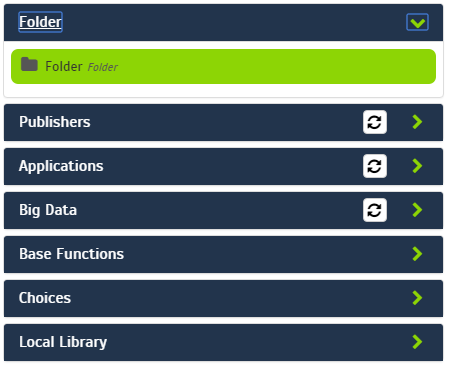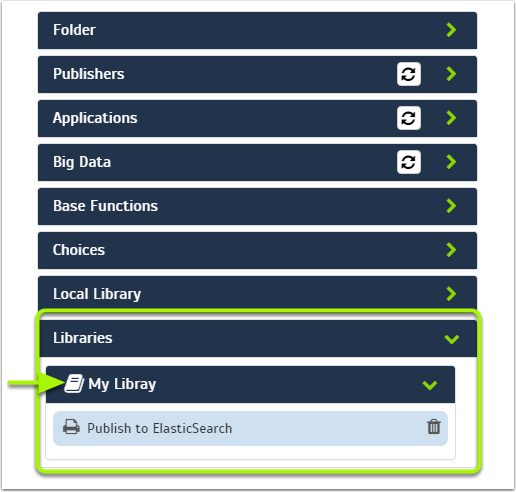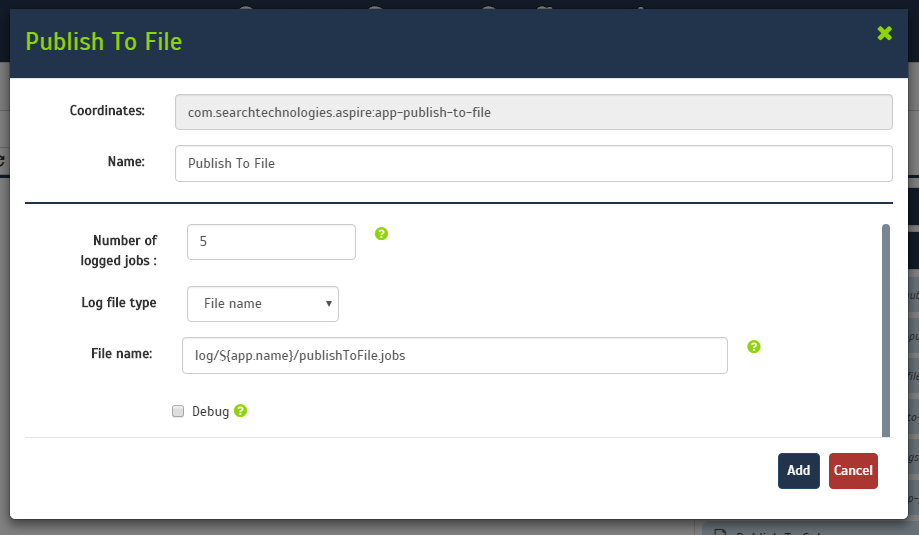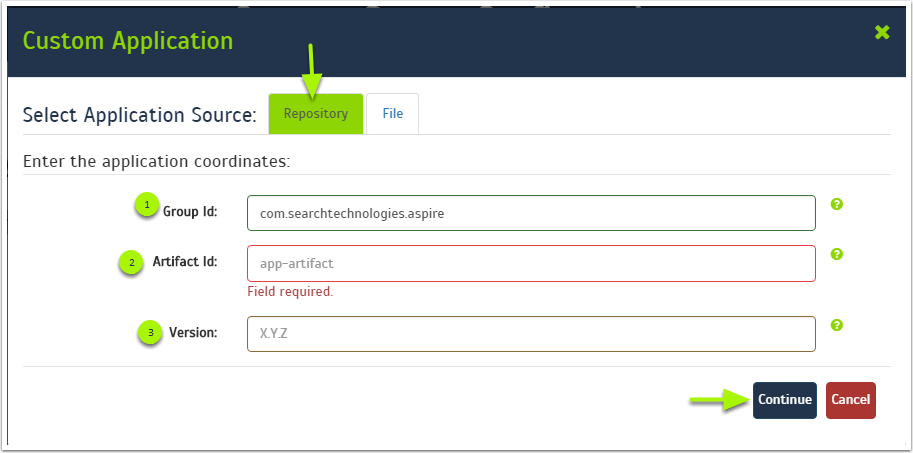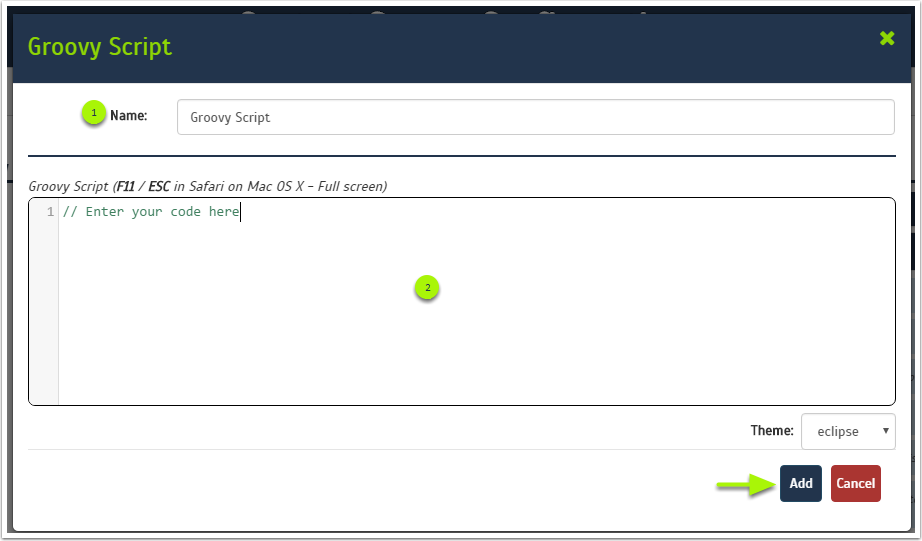The Workflow is divided into two parts: the Workflow Library and the Workflow Tree.
Workflow Library
Categories
Folder
The folder is used to group a set of rules into one branch which later can be moved, shared or disabled.
Publishers
With the Publishers you can publish the jobs coming from the connector and into a search engine, each publisher must be configure before it's added as a application rule. They are all downloadable java applications.
Applications
The Applications are used to modify the jobs coming from connector in a more complex way that a simple Groovy script could had done. They are all downloadable java applications.
Big Data
The Big Data category holds all the big data related applications such as Co-occurrence, Hadoop Job Launcher, among others.
Base Functions
The Base Functions are scripting rules base on Groovy that can do simple functions to the jobs, it also has rules that can skip or stop the process of a job in the workflow. You can also create your own custom rules.
Choices
The Choices are scripting rules base on Groovy that allow us to create branches in the workflow base on a decision, this branches are only be executed by the jobs that comply with the made decision.
Local Library
The Local Library category, holds all the rules used in the current workflow, even the shared rules used in the workflow. Dragging the rules from this category will just create a reference to the existent rule
Share Libraries
The Shared Libraries are sets of rules and applications we save to use with other content sources. If a rule or application is not in a share rule, we can't use it again in another content source.
How to Share a Rule or Application?
This section walks through the steps necessary to share any rule or application with the enabled menu.
Step 1: Open the Context Menu
- Right click over the rule or application we want to share, if it can be shared, the Share option should be enabled.
- Put the mouse over the Share, this should open the sub menu
- Click the New Library option, this will open a window where we can put the name of the library.
Step 2: Create the Share Library
- Enter the name of the library
- Click on the Share button, this will create the share library with the rule or application inside of it.
Step 2.1: Check the Share Library
- Go to the Workflow Library, the new category Libraries should be visible by now.
- Click on Libraries category to show all the shared libraries available, your new library should be visible.
- Click on your library to show the shared rules in the library.
You can delete a shared rule by clicking on the trashcan next to the name of the rule in the Workflow Library
The share library may change position if we have several shared libraries, this is because is going to sorted by alphabetical order.
Step 3: Share to a existent Share Library
If you already have a share library and you want to add a new rule or application to it, repeat Step 1 and instead of clicking over New Library we can click over the name of our library, this will add the rule or application automatically.
Step 4: Unshare a Rule or Application
- Right click over the rule or application we want to unshare, if it is shared, the Unshare option should be enabled.
- Click the Unshare option, this will remove the rule from the shared library.
Workflow Trees
Controls
The controls for the Workflow Tree are explained in the Admin UI Content Sources. But the most important control for the Workflow tree is the Tree Selection. With this control we can select the tree we want to modify, and we can see it in a representation of the information flow, also we can see the description of each tree just by putting the mouse over the button. The current tree will be highlighted in green
Rules Hierarchy Restrictions
For some rules there are some restrictions of which rules can contain which one, in the list below we can see which rules can contain which types of rules.
Root
- Folder
- Publishers
- Application
- Big Data
- Base Functions
- Choices (but not the Condition)
Folder
- Folder
- Publishers
- Application
- Big Data
- Base Functions
- Choices (but not the Condition)
Condition
- Folder
- Publishers
- Application
- Big Data
- Base Functions
- Choices (but not the Condition)
Choices
- Condition (Only)
Add a rule or application to the Workflow Tree
This section walks through the steps necessary to add any rule or application to the Workflow Tree.
Step 1: Drag from the Library
You can add any rule or application just by dragging the rule from the Workflow Library and dropping it in the part of the Workflow Tree you want to put the rule or application.
Step 2: Fill the properties
If the rule needs to be configured, it will open a window with all the configuration properties, otherwise it just will appear in the tree. If a window is opened just fill the necessary properties and click on the Add button to create the rule.
Step 2a: Update the properties
By double clicking the rule on the tree, we can open the window it the current properties of the rule. Then we can change the properties and save them by clicking on the Update button.
Context Menu
Custom Applications and Custom Script
Custom Applications
This includes the Publishers, for which all related information can be found on this page, Applications that at the moment includes the Hierarchy Extractor and Mime Type Normalizer, and Big Data.
By dragging and dropping the Custom option of publishers or applications, you will open a window from which you can choose between two methods to install a custom application, publisher or big data, repository and configuration file, both shown as tabs on the top of the window.
Repository
The repository method is always the default one, with this option we can download the custom application, publisher or big data from a maven repository. To install the custom application, publisher or big data you need to fill the following fields:
- Group Id: e.g. com.searchtechnologies.aspire
- Artifact Id: The id of the artifact representing the connector e.g. app-custom-connector
- Version: (Optional) If the version of the artifact isn't specify, Aspire will use the same version as it.
- All the Applications, Publishers and Big Data added using this method will be added to their respective category in the Workflow Library.
- It is not recommended to use an older version of anything if a new version is available.
Configuration Files
Before accessing the configuration file method an alert will be show indicating that the application/publisher added using this method are not going to be included in the respective category in the Workflow Library.
The configuration files method requires to have both application file and dxf file (in this format <application>-dxf.xml) in the same folder on the server machine. To install the custom application, publisher or big data you need to fill the following fields:
- File Path: Enter the path to the application.xml file. It can be a full path to the file or a relative path from the aspire instance folder (e.g. config/application.xml)
After you have all of the necessary fields, click on continue and the application will be loaded in the same window.
If the dxf file doesn't have the new valid format for application, publisher or big data, it won't be possible to open the configuration.
Custom Script
By dragging and dropping the Custom option of Base Functions, you will open a window where we can add you own groovy script to manipulate the jobs.
To add the custom script you need to fill the following fields:
- Name: Add your script's name
- Groovy Script: Enter your script
Groovy Script with Eclipse Theme
Groovy Script with Twilight Theme
- You can go into full screen by selecting the textarea, and pressing the F11 or the Esc key (only Esc key works on Mac OS X)
- You can change the textarea theme from the Theme pulldown
